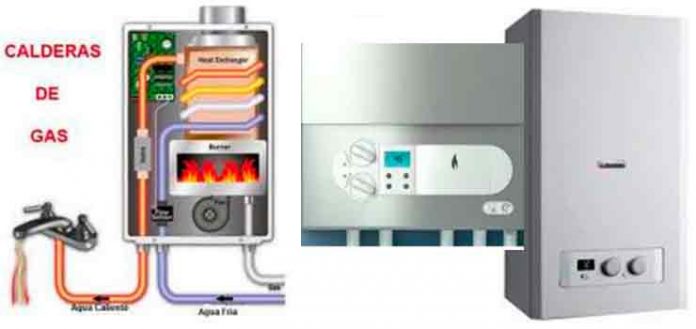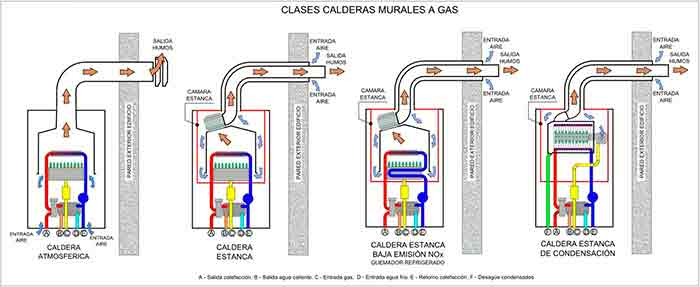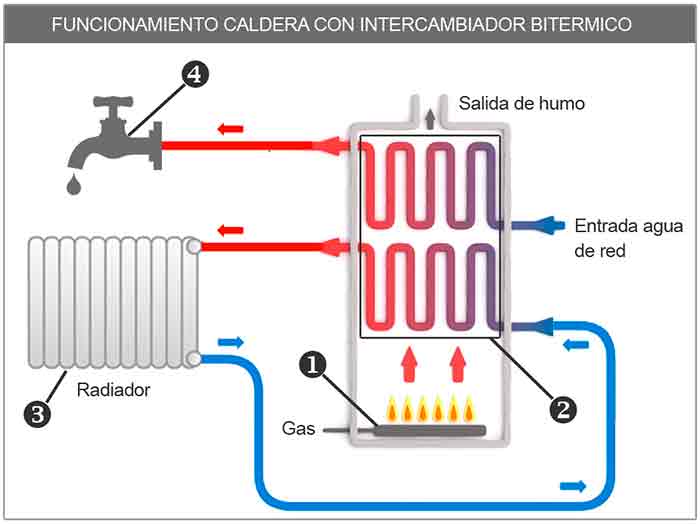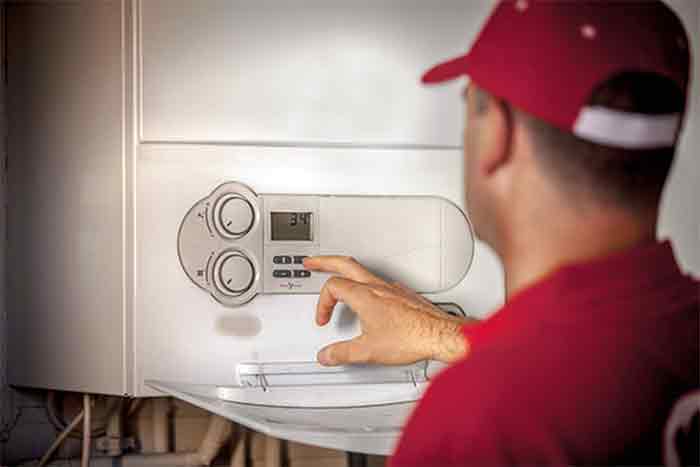
Now that the cold is coming, and it will stay for several months, it is time to condition the house properly as well as efficiently. For this reason, we will dedicate this article to talking about gas boilers for homes as one of the most successful options.
We will explain the different types of gas boilers that are marketed, their advantages, and what maintenance tasks consist of.

Types of gas boilers for homes
To correctly choose the gas boiler that best suits your circumstances and needs, it is essential that you know the different types that exist. So let’s see…
Depending on the combustion system
Within this operating system, there are…
Atmospheric gas boilers
This type takes the air necessary for gas combustion from the room in which it is installed. Precisely this operation makes it less safe than other types of gas boilers, which is why, since 2010, its installation is prohibited.
Sealed gas boilers
Then we have the sealed boilers, which are the ones with a completely closed and sealed combustion chamber. This prevents the gases produced by combustion from entering the passenger compartment where it is installed.
Therefore, they are much safer for home use.
Depending on your installation
Floor standing gas boilers
On the one hand we have the standing boilers that, as can be assumed, go directly on the ground.
They are larger than wall-mounted gas boilers, but also more powerful, which is why they are the ones that are usually used in single-family homes.
Wall mounted gas boilers
And, on the other hand, there are the mural boilers that are hung on the wall at half height. Smaller in size than the previous ones.
These are the most commonly used in standard floors.

Depending on its operation and performance
In this segment we find three classes of gas boilers for homes.
Standard sealed boilers
This type of boiler, being older than the other two that we will see below, has been superseded by providing lower energy efficiency.
To a certain extent, it could be said that they are, or are beginning to be, “out of print” from an efficiency point of view.
condensing boilers
Their name comes precisely because they condense the vapors that come from combustion, inside the boiler.
This type stands out for its low carbon dioxide emissions as well as its high performance.
They are gas boilers are highly recommended for homes that have radiators and underfloor heating.
Low NOx boilers
Low carbon dioxide emission boilers, better known as low NOx boilers.
The characteristic of this type of boiler is that its burner is cooled by water. However, its performance does not exceed that of combustion boilers, being located between the two previous types.
Technical advice
Regardless of whether you know in general terms the different types of gas boilers for homes, you will need the advice of technicians in the field who, in addition, will be the ones who carry out the installation.
This is another choice you shouldn’t make lightly. Look for a company of recognized professional prestige, and from which you can obtain references. We have carried out, as a test, an internet search and, among the best options a priori, we find https://www.oscagas.es/.
Why this company and not another?
Two of the advantages that have caught our attention and that provide us with a certain peace of mind are:
On the one hand, they have a repair service 365 days a year, 24 hours a day. And on the other hand, they have the “endorsement” of Gas Natural, having recognized it as the “best installation company in the north of Spain”.

Maintenance of gas boilers for homes
Once we have chosen the most suitable gas boiler system for us, and installed it, we have to take into account another very important thing: Maintenance.
Carrying out regular and correct maintenance brings advantages such as a longer useful life of the equipment, fewer breakdowns, greater efficiency, therefore more economic savings, and less damage to the environment, among others.
In case of malfunctions, in which the intervention of a professional is necessary, there are maintenance operations that we can carry out ourselves, as you will see below.
Check all connections
At the beginning of the winter season and before starting up the heating equipment, it is necessary to check that all the connections are in order, thus avoiding poor operation that could increase energy consumption or, worse, cause a breakdown.
Therefore, we have to check the electrical connection, the water inlet and outlet connections and pipes, as well as the gas connection.
circuit pressure
Another operation that we must carry out before putting the equipment into operation is to check the pressure.
The pressure of a gas boiler for homes ranges between 1.2 and 1.5 bars.
The pressure indicator is visible. It also has a key with which we can increase or decrease the pressure.
Therefore, this operation is as easy as checking the tire pressure of a car.
purge the radiators
It should also be known that radiators accumulate air, therefore, at least once a year, this air must be removed, which is called “purging”.
What does purging radiators consist of?
It is a very simple operation. All you have to do is open a valve called a “bleeder” and let the air out.
How do we know how long to leave the trap open?
When opening it we will hear a whistle that will last until the air is completely emptied. When this happens and some drops of water begin to fall, it will be time to close the tap, and we will have the emitters ready.
Select the temperature
The selection of the optimal temperature is essential both for our pocket and for the environment.
It is preferable to maintain a lower but stable temperature throughout the day. You have to know that from 21º, consumption increases inefficiently for each degree we go up.
These tips are enough for you to efficiently enjoy heating your home throughout the winter months, and for many years to come.



